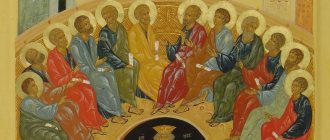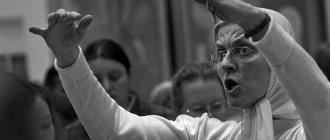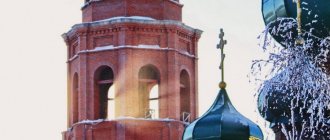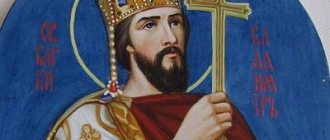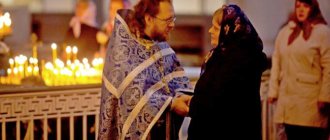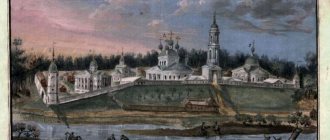The monastic community must be united in Christ and inseparable from the church people
The Nikolo-Peshnoshsky Monastery, located in the Dmitrovsky district of the Moscow region, is one of the oldest monasteries in Moscow Rus' - this year it celebrates the 660th anniversary of its founding. June 27 is the patronal feast day here - the memory of the founder of the monastery, St. Methodius of Peshnosha. On the eve of the celebrations, the correspondent of the Monastic Herald spoke with the abbot of the monastery, Abbot Alexy (Gorlychev).
Father Alexy, they say that everyone who pleases God is, in one way or another, present in the places of their feat. Do you feel a connection with history, with your predecessors who labored here earlier?
Of course, we consider ourselves part of the school of St. Sergius. The first abbot of our monastery, the Monk Methodius, was one of the closest students of the abbot of the Russian Land. Of the huge number of monasteries that were founded by the disciples of the Radonezh Abba, ours is included in that small circle of monasteries - as far as I remember, there are only nine of them - that were founded by St. Sergius personally.
At first, the Monk Methodius retired to these places to live as a desert. He built himself a cell. Once Abba Sergius came to him to visit his student and pray and talk together. Seeing that he, as previously secluded himself, remained to live among the swamps, but the brethren were already gathering to him, he still advised him to choose a more convenient place to establish a cenobitic monastery. Together they found one nearby, just a mile away, on the other bank of the Yakhroma River. Having prayed together, Saints Sergius and Methodius founded a monastery that has stood here for more than six and a half centuries. Initially, it was built from logs that the Monk Methodius himself carried across the river on the bridge - “carrying on foot,” as the people began to call the monastery of Peshnoshskaya.
It is known that St. Sergius visited our monastery more than once. Together, the Reverend Fathers Sergius and Methodius dug ditches for cells here, dug two ponds and planted an alley of elms. The spiritual connection with St. Sergius and the Lavra continues to this day. In the 18th century, our monastery was even subordinate to the Trinity-Sergius Lavra.
By the end of the 18th century, the monastery was ruled by one of its most prominent abbots, Archimandrite Macarius (Bryushkov). This is a student of the venerable elders Theodore of Sanaxar and Cleopas of Vvedensky. He was in spiritual communication and correspondence with the Monk Paisius (Velichkovsky). Here the Athos charter was introduced, and the eldership was born.
It was from here that this spiritual tradition was later transferred to Optina Pustyn. There, at the request of Metropolitan Platon (Levshin), Father Macarius sent the Peshnosha “gardener” Abraham and with him twelve other monks. Father Abraham became the Optina builder-abbot, restored the Vvedensky Cathedral, erected the three-altar Kazan and Vladimir churches, and a bell tower. Among the twelve monks was novice Alexander Stepanov, later Hieroschemamonk Afanasy Svensky Jr., who trained the first Optina elders, the venerable brothers Moses and Anthony (Putilov), who, with his blessing, established the Baptist Skete of the Optina Monastery and laid the foundation - along with Elder Leo - for the Optina eldership.
In general, the disciples of the Peshnosha Archimandrite Macarius were abbots of twenty-four monasteries. Among them: Davidova, Berlyukova, Zadne-Nikiforovskaya Vazheozerskaya and Krivoezerskaya hermitages, Golutvinsky, Vysokogorsky Churkinsky, Moscow Sretensky, Belopesotsky and others. Many monasteries adopted the charter of the Peshnosh monastery; So they asked: “to give a few of the brethren to establish a hostel in the image of Pestusha (Peshnosha in the old transcription - Ed.).” Among those who left here were revivalists of monasteries that had previously fallen into disrepair, already glorified as saints - such as, for example, the Venerable Elder Isaiah of Vazheozersky. The main renewer of Russian monasticism on Athos after the Turkish persecution, the hesychast and seer Father Arseny of Athos, also passed his new beginnings on Peshnosh. Many saints and ascetics were disciples of the Peshnosha natives: the Venerable Hieroschemamonk Nil of Nilo-Sorsky, the Venerable Maria of Olonetsk, the desert dweller Anastasia of Padanskaya, etc.; and also: the abbots of the Panteleimon Monastery on Athos Gerasim and Jerome, the founders of the St. Andrew's skete, Hieroschemamonk Vissarion (Tolmachev) and schemamonk Barsanuphius (Vavilov), who took as the basis for the charter of the St. Andrew's monastery the charter of the Beloberezh Hermitage, one of the compilers of which was the same one who was once sent to Optina among the twelve monks Hieroschemamonk Afanasy (Stepanov).
In the letters of Saint Ignatius (Brianchaninov) there are the following lines: “There was a time when the White Shores were full of well-meaning monks, there were times when Pestusha was full of them, the Ploshchanskaya Hermitage was full of them in its time; now the time has come for Optina; the time of color will pass as usual, and other places will flourish, also in their own time...”
What brings monks into proper spiritual order?
In addition to its rich history, what do you see as the peculiarity of the monastery now?
Of our Peshnosha brethren, five have been glorified as venerable martyrs. One of the former inhabitants of the Nikolo-Peshnoshsky Monastery, Hieroschdeacon Alexander (Zhemkov) lived not far from the monastery; he cared for the people as an elder. He died in 1967. The monastery began to be revived only 40 years later.
Our monastery is located far from main roads - you can’t just stop by here “on the way”. If they come to us, it is specifically to pray. The monastic spirit is not emasculated by the constant presence of many tourists. There are now only eight brothers. Therefore, liturgical and economic obediences require the full dedication of each of the fathers. Glory to God, everyone is a worker, and for the sake of serving the Lord, everyone sincerely gives their all in their obedience.
The zealous splendor and order in the monastery are truly amazing...
The main contribution to the revival of the monastery was made by the former head of the Dmitrovsky district Valery Vasilyevich Gavrilov. From 2007 to 2014, in seven years, the monastery was practically restored, and the long-awaited opening of the entire territory of the monastery took place. The festive service was then led by His Holiness Patriarch Kirill in 2014. This was the stage of completion of reconstruction after complete desolation, but the work of “cultivation and storage” is incessant.
Each of the brothers probably has several obediences? With a small brethren, how is it possible to distribute the load so that the work gets done and the internal benefit for each individual brother can be taken care of?
Of course, focusing on obedience alone is a luxury in our conditions. As well as following, let’s say, exclusively everyone’s calling. But, on the other hand, we still take into account what someone’s soul is about, what abilities a brother has - we try to use everything for the glory of God. If a person has a predisposition to do something, he will succeed in it. And if he treats work as obedience, he will still receive spiritual benefits.
We do not create problems for ourselves artificially. In our situation this is somehow inappropriate. Given the small number of brethren, there is no need to find additional difficulties, even with good ascetic intentions. And so the burdens that we bear, performing several obediences, observing the liturgical rules, the monastic rule, are sufficient for us to constantly find reasons for self-reproach. And repent and humble yourself. Everyone has weaknesses that must be overcome, illnesses that must be endured - this is all the cross that the Lord has given to everyone according to their strength. And we need to bear this burden without grumbling, with gratitude.
You feel some kind of complacency spreading throughout the monastery - is this a pre-holiday feeling, or is it always like this?
Anything, of course, can happen: what kind of salvation is there without sorrow? Elder Paisios said: even good people, when they are tired or sick, can be irritable. When you come to serve the Liturgy, you feel that you are not in the mood... What should you do? It always helps me to remember: maybe this is the last Liturgy in my life?.. There are a lot of accidents around. I fell ill with the same Covid. Or the blood clot breaks loose and - instant death. How many people of the same age have already gone to the Lord in this way? Are you ready to stand before God? So mortal memory immediately leads to proper dispensation.
We draw strength from serving the Liturgy. The grace that we receive in the sacraments, prayer, and above all during divine services, covers everything and helps us. I can say about myself, and I think every monastic will say this: I would not have withstood all those tests that are inevitable in monastic life if it were not for this strengthening grace of God.
It is known that when the Hieromartyr Seraphim (Zvezdinsky), being the Bishop of Dmitrovsky, installed as abbot the last abbot of the Nikolo-Peshnosh monastery before the ruin in the 20th century - Hieromonk Varnava (Zhukov), he said, as parting words: “Take the rod. Accept it. The storm raises waves, the sea is agitated, the Lord gives you His ship, the Peshnosh monastery. Steer the ship like a good helmsman. Here are the pitfalls, look, if your ship would not run aground, it would not break. Pitfalls are the hearts of the brethren of the monastery entrusted to you. Look vigilantly, look vigilantly... Oh, if you knew what awaited you at your post, you would give me the rod back now, but you can’t do that. Accept it and guide the ship to a quiet harbour.” Father Barnabas, by the way, having listened, immediately tried to give the rod: “It is beyond my strength, holy lord, you give me obedience. I am a simpleton and an ignoramus, and my strength is weak.” But the archpastor, blessing him, crossed him three times with the words: “May the Lord strengthen you, may the Lord have mercy on you.” It is clear that the previous century was a century of special trials. But these are difficult times for us too. Thank God, the brethren in the monastery, I would also put it figuratively, after all, it is not “rocky ground” (see Matt. 13:3-9). Although, of course, each of us always has something to cultivate internally in our souls.
Whatever we do, we must become capable of receiving grace. This is, firstly. And secondly, everything must be done for the sake of Christ. The Monk Seraphim of Sarov spoke about this in his famous conversation about the purpose of Christian life. Otherwise, everything is really very shaky. Today you are building a church, and tomorrow there will be a fire or some kind of social cataclysm and: - conflagration and ruins? Everything is in the ways of God's Providence. It is said in the book of the prophet Isaiah: I am God, create peace and builder of evil (Is. 45:7). That is, what we perceive as disasters is allowed by God. Only the treasure stored up in Heaven never decays (see Matt. 6:20). Elder Paisios said: just as a radio must be tuned to the desired frequency, so we, no matter what we do, must come to the proper internal order.
The main thing is to maintain filial trust in Christ
Is it only mortal memory and a sober attitude towards trials that help one find inner peace?
This is probably not our measure: to constantly remain in mortal memory. We sober up differently. I myself have always had a lot of obedience, so I was overcome by murmurs: “What is this, Lord?!! I need to serve the Liturgy, but here there is cement, gravel, everything needs to be sorted out with the workers... My head is spinning...” But if you sigh to the Lord in a filial way, He will send down a spiritual answer to all your claims. Although, of course, this was not always the case. But here you are spinning and spinning, you seem to be struggling with all your strength, and suddenly you have such a clear, calm picture in your mind: this needs to be done this way, this needs to be done like this... Everything is exactly laid out on the shelves and - no unnecessary movements, no unjustified expenses.
All our breakdowns and confusion are due to lack of faith. How many times has it been rechecked: if we rely on ourselves - I will, they say, act based on my experience - for some reason such a fuss falls on us that simply devastates you. But when you trust God in prayer, a state comes that everything that is complex suddenly becomes simple. You get things done, many of them, but without stress and on time. It’s as if someone is starting to tell you: do this here, put this aside, just tweak this there.
Do you have to learn from your predecessors?
This is how our famous abbot Archimandrite Macarius (Bryushkov) acted? He was appointed to the Nikolo-Peshnoshsky monastery for obedience. Here then, due to the anti-monastic policy of Peter I and then Catherine II, everything was in such a deplorable state that he looked and, as the chronicle says, “fell into evil despondency.” Even for a person of high spiritual life, everything inside seemed to have broken off! What can we say about us... But he did not give up prayers and trust in God. Then St. Sergius and St. Methodius appeared to him in a dream and said: “Stay, don’t go anywhere, everything will be here.” His soul calmed down. He began to work and raised the monastery to a very high level of both spiritual and external well-being. The strict Athonite rules, eldership, and numerous spiritually strong brotherhood were organically combined here. The Father Superior himself was both a wise confessor and an excellent hardworking business executive.
Doubts are usually expressed: is one compatible with the other?
But he succeeded: in his activities the external was balanced by the internal and vice versa. And this is a very important counterbalance. Otherwise, extremes cannot be avoided. So, among monastics, some sometimes believe that all worries about material things are from the evil one, “much worldly care” only dissipates prayer, we, monks, have chosen one thing for our needs, etc. Others, on the contrary, are ready to rebuild and rebuild churches, new buildings, gild crosses and domes, improve belfries, build some greenhouses, chicken coops, forgetting about internal work... It is always more difficult to follow the golden middle path.
Elder Paisios said that demons “work together” with us if they see that we are going astray: they strive to push us further in the direction where we have deviated. How to get rid of these “helpers”?
That is why it is said: narrow is the gate and narrow is the way that leads to life, and few find it (Matthew 7:14). Many Russian monks passed through these narrow gates and narrow paths. We must combine a spiritual attitude, depth, and attentiveness with those works that do not harm us. Of course, it is difficult to find such harmony, especially since it is different for each person. It is clear that the spiritual is a priority in any case: Seek first the Kingdom of God and His righteousness, and all these things will be added to you (Matthew 6:33). If a person sincerely tries to serve God, each in his own rank, in his own place, the Lord will help. All our labors are aimed at the glory of the name of Christ. So even if you happen to fall into “evil despondency,” there is no need to despair. Let's pray, and the saints will help.
The Lord is in the monastery and lack controls for everyone's benefit
What advantages does a small monastic community like yours have now?
When there are three or four people in a community, it must be hard. And if it’s more, but not so much, it gives a feeling of community-family. Everyone knows each other closely, is aware of all everyone’s problems, and is always ready to help their brother in Christ, sympathize, and respond. We don’t even have any kind of strict hierarchy or regulation within the brotherhood: here he is the eldest in obedience, the rest are subordinate to him - with us everything is decided in a family way, in the spirit of complementing each other.
And the people somehow reach out on their own, knowing that we always have a shortage of workers - they are happy to come, help, communicate with the brethren. Especially if they are the children of one of the hieromonks. So, in their labors, they can calmly pray here themselves, and discuss in more detail some of their problems with their confessor. In these hectic days, it means a lot if you even just listen to someone. Shepherding is in short supply right now. The parish priests are heavily burdened with social obediences and demands. At confessions, so many people line up to see them that there is simply no way to delve into what is there, in the depths of everyone’s soul.
And people come to us on weekends, on vacations, or on some free weekdays. We work together and communicate. People today, especially young people, often exchange messages a lot in the virtual space. But real human communication is in short supply. Especially if this is a conversation on a spiritual topic. At confession, it is still appropriate to repent of sins, but you cannot always ask the priest for a conversation, knowing about his workload. But it is in dialogue that a person can understand something for himself, understand some of his bewilderment or even misconception.
The Lord is in the monastery and lack controls for the common good, for the salvation of souls. For us, both this help and the invariably personal level of relations between the brethren give a special warmth to conciliar prayer. The monastic community, like leaven, must be united and inseparable from the church people. This, by the way, is a feature of the monasteries of the Sergius tradition. St. Sergius also cared for the people, as did almost all of his disciples.
Just like a leaven intended for everyone, this genuine churchliness is now easier to feel in a relatively small community. Previously, when the whole society more or less strived to live in accordance with the ideals of Orthodoxy, and people from childhood, as they say with mother’s milk, absorbed Christian values, even if someone stumbled, but in general the concept of what to strive for that there is a norm, that there is a sin - there were among the people. At that time, hundreds of monks gathered in the monasteries, and everyone was of one mind with each other - this was not difficult to achieve in the general mainstream of social life. Now it’s different. But with God’s help: whoever the Lord has determined to be in which monastic community, each serves in his own place.
Photo: Vladimir Khodakov Photos from the monastery archive were also used
How and when did the first monastic communities and orders arise?
The first monastic communities grew out of the spirituality of Christian hermits who went into the desert of northern Africa in the third and fourth centuries. In those days when there were no monastic rules and organized monastic life, these were individual laymen - men and women who felt the special call of the Holy Spirit to acquire the Kingdom of Heaven. They were not yet able to express this massive and very personal calling in any organized, communal form, but they perfectly felt the strongest call of God to go to safety in the desert, full of dangers, temptations, loneliness and... the inexpressible presence of God. Only a few centuries later, the pillars of monastic life were born in the Western Church - Saints Benedict of Nursia, Bernard of Clairvaux, Francis of Assisi, Dominic, Ignatius of Loyola - who captured the separate and specific charisma of the orders they created on the pages of their charters.
Let us note that the evangelical advice on celibacy did not presuppose the stable communal or apostolic life that has become characteristic of monasticism.
In the very early days of the Church, a distinction began to be established between Christians who married and those who chose to remain celibate. In some early Christian communities, celibates from the earliest times tended to be united in a special category - the rank (or order) of virgins. Let us remember the admonitions of Saint Ignatius of Antioch, who warned virgins against arrogance towards those who were married - and then there were even bishops among them. In the first decades of the Church, the life of ascetics did not differ from the life of the entire Christian community by any external signs: they participate in the Eucharist along with everyone else, dress like everyone else, do not rely on any rules of community life, remaining in their family or wandering. In the early days they also did not take a public vow of celibacy. For virgins living in their families, special rules were quickly established: intense prayer, service to the poor and sick, and refusal to participate in worldly shows. In an effort to overcome gender differences and anticipate the angelic state on earth, men and women sometimes lived in the same community - but this tendency would later be eradicated. The order of consecrated virgins especially flourished by the fourth century, providing a striking example of “domestic” asceticism, while small communities of monastics were distrusted and subject to criticism (such as the Sarabaites).
As for widows, they were also united from the very first times into a special rank - an “order”, in many ways similar to the rank of virgins.
Established monasticism began in the fourth century. At the beginning, both Western and Eastern monasticism had much in common. Historical data indicate that various forms of monasticism arose almost simultaneously: hermitage, cenobitic monasticism and other forms located at the intersection of hermitage and community life.
In Egypt, Saint Anthony became the exponent of hermitism (which did not necessarily mean complete isolation). Cenobitic forms of monasticism were organized in Egypt by Saint Pachomius, and in Asia Minor by Saint Basil. With the help of the monastic community, they sought to avoid the risks associated with hermitage, as well as to conform to the biblical example of community life described in the Book of Acts of the Holy Apostles. They also adopted this form in order to do the works of mercy spoken of in the Gospel - and this is only possible in the community.
Gradually, monasticism began to stand out more and more against the background of Christianity as a whole, rethinking various aspects of life: work, sleep, prayer, fasting, education and science, relationships with the opposite sex, and so on.
In the East, hermitage was more developed than in the West, where the predominant form of monasticism from the very beginning was a community life. Western monasticism experienced a special flourishing in the 5th-7th centuries, thanks to St. Augustine, who laid the foundation for the community of clergy, and then to St. Benedict, whose charter was more oriented toward monks who did not have holy orders.
By the early Middle Ages, two ranks – “ordines” – gradually formed: the rank of monks and the rank of canons. The rank (or order) of canons consisted of monks who served at cathedrals. At that time there was no compulsory celibacy for priests, and the appearance of canons was a step towards the introduction of compulsory celibacy for priests in the West. The clergy, despite celibacy, does not belong to monasticism, and at that time there was no such term that would unite these two types of celibacy for the sake of the Kingdom of Heaven, and the term “ordo”, order, then included not only celibates, but and other associations of believers, including married people. In the evolution of the canons, a major role was played by the Rule of St. Crodegang, Bishop of Metz (762), which was most expressed in the Order of Premonstratensian Canons Regular, founded in 1120.
This concerns the orders of canons. In the development of monastic orders, the Charter of Saint Benedict played a decisive role, on which not only the Benedictines, but also the orders of the Carthusians, Cistercians, Camaldoleans, etc., which were created in the 11th-13th centuries, relied.
During the same period, military monastic orders appeared, the need for which arose due to the spread of Islam. The first such orders - the Hospitallers of St. John and the Knights Templar - were founded to assist pilgrims to the Holy Land. Military monastic orders flourished in the 12th-15th centuries. Gradually, most of them lost their religious character and turned into a kind of association of the nobility, but some retained the original design - for example, the Order of Malta or the Teutonic Order.
In the 13th century, the so-called mendicant orders began, founded by Saint Francis and Saint Dominic. The formation of these orders largely depended on the development of cities and population growth in Europe. Therefore, such communities do not retreat into the desert, but remain in a social context - they preach, perform the Sacraments for believers, and provide pastoral care. The new orders played a big role in the development of the economy - just remember the original Monti di Pieta banks for the poor, created by the Franciscans. Mendicant orders are characterized by clericalization: the Order of Preachers, founded by St. Dominic, was already conceived as a priestly one, and the Franciscans, although they began as a community of laity, had already been clericalized for 20-30 years. Following the first mendicant orders, the Augustinians, Carmelites, Servites and others appeared.
This new type of monasticism is characterized by centralized management - there is a chief abbot and provincial abbots, and these positions are elective and temporary. Great emphasis is placed on poverty and non-covetousness - before the advent of the Little Brothers, this aspect was pushed aside due to the fight against the heretical tendencies of the pauperist movements.
The balance between monastic, solitary life and apostolate is not immediately established. This fact, as well as the exorbitant growth of various orders, leads to the need to regulate their lives, and even to the banning of some of them. During the period of the emergence of mendicant orders, the canonical form of monastic vows of poverty, chastity and obedience was consolidated.
Along with men's communities, women's communities are also developing. At first, the nuns formed a branch of the male orders, and church authorities for a long time did not agree with the nuns' claim to create their own structures like male abbeys.
Over time, the number of orders increased, year after year, century after century, the most diverse communities of contemplative and apostolic life were created, which began to be called “congregations,” then societies of apostolic life appeared. New models of community life, new forms of apostolate are emerging, keeping pace with the entire Church. Today we use the term “consecrated life” more often, and the word “monasticism” is used more to refer to contemplative communities or orders dating back many centuries. The history, essence and evolution of this form of Christian life is concentrated in the decree of the Second Vatican Council “On the renewal of monastic life in relation to modern conditions” - it is precisely this and subsequent documents of the Magisterium of the Church that modern monastic communities are guided by, the constant goal and calling of which remains the same as and in the first decades of the Church: “to follow Christ with greater freedom and to imitate Him more closely” (Perfectae caritatis 1).
Based on materials from Vatican Radio

